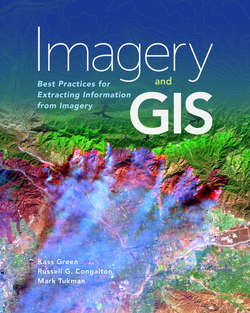Читать книгу Imagery and GIS - Kass Green - Страница 62
На сайте Литреса книга снята с продажи.
Will the imagery be used for visualization, or to make a map?
ОглавлениеImagery is most often used as an aid in the visualization of map information. Imagery used in map visualization allows the user to understand the context of a location—to be able to visualize its surroundings. The most readily available imagery is served for visualization to mapping websites such as ArcGIS Online, Bing, Apple, and Google at no charge to the user. Usually, imagery for visualization is optical and served in true color. For example, a common base image, Esri’s World Imagery, is served at no charge in true color and is created from a variety of sources at multiple scales including Landsat, NAIP, WorldView, and Pleiades imagery. Imagery used for visualization is always dated, because it is derived from archive imagery. However, the currency of visualization imagery is rapidly increasing with the increasing supply of worldwide high- and very-high (HVH) spatial-resolution imagery.
However, the imagery in visualization applications is available only for viewing and not for analysis. It is made available as cached, tiled services, which offer imagery in highly compressed JPEG or PNG format (please see chapter 5 for more detail on image compression). As a result, the band combination that is displayed (usually natural color or color infrared composite) cannot be changed by the user, and the pixels values are not available for analysis. These constraints limit how much information can be derived from the imagery.
While suitable for heads-up digitizing of objects easily discernible (e.g., streets, buildings), the cached imagery does not provide enough data for deciphering subtle changes such as vegetation types or camouflaged items. The creation of many maps requires that the values of the imagery pixels be available for digital analysis. Most cached imagery is also not current enough to support disaster response activities.
